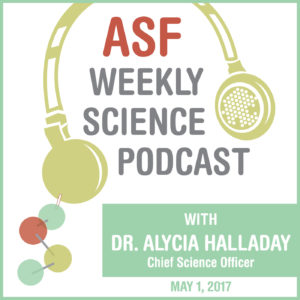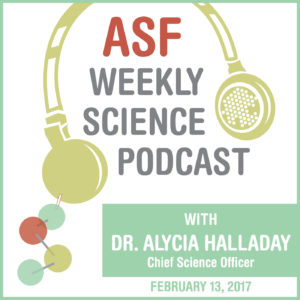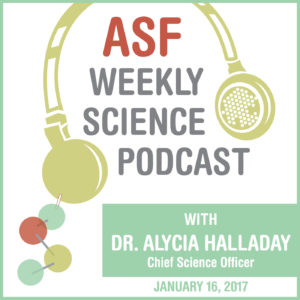On this week’s podcast, diagnosis with the DSM 5. While much work needs to be done to include individual abilities and disabilities into the DSM5, after the CDC prevalence numbers were published last month, it became clear the old DSM IV was not working. In a replication of a previous finding, it showed that the DSM IV categories of Aspergers, PDDNOS and autistic disorder were just not being used consistently across states, and left the interpretation of those diagnoses somewhat meaningless. While DSM 5 is a step in the right direction, more work needs to be done to ensure everyone is receiving the most specific diagnosis possible, and getting the services they need. Listen to the podcast here.
On this week’s podcast, two chief science officers! Dr. Alycia Halladay interviewed Dr. Thomas Frazier of Autism Speaks on what’s needed to improve clinical trials and drug intervention for autism. The two CSOs also discussed other important in ASD research, including disclosure of a diagnosis, sex differences, and some of the newest more exciting findings.
On this week’s podcast, Dr. Lori Sacrey of the University of Alberta highlights findings from a multi-site study she led that investigated how well parent report measures could predict an ASD diagnosis for at-risk infants. Plus, the journal Autism decided to move away from the puzzle piece symbol in this new era of autism research.
 Scientists have studied males compared to females with autism, but rarely have there been studies about what clinicians see as differences in these two groups. Given that they provide insight on diagnosis, needs and access to services, it is kind of important to talk to them, and a study out this week in the journal Autism did just that. Click here to read the study.
Scientists have studied males compared to females with autism, but rarely have there been studies about what clinicians see as differences in these two groups. Given that they provide insight on diagnosis, needs and access to services, it is kind of important to talk to them, and a study out this week in the journal Autism did just that. Click here to read the study.
Also, scientists are starting to understand the role of exposures in parents and how they affect diagnosis of autism in their children, but this week a new wrench was thrown into the wheel: researchers in the UK found that grandparental exposures play a role in autism diagnosis too. Luckily, this too is open access and you can read it for yourself here. It was covered in the media and we have perspective from a parent included.
Click here to listen to this week’s podcast with Dr. Alycia Halladay.
 This week two studies which examined infants and younger children that will significantly advance understanding of causes and services for people with autism were published. After a commentary about the confirmation of Betsy DeVos, the study that used a practical methodology to improve autism screening in pediatrics clinic from researchers at Duke University was presented. After that, some early results from the EARLI study, which examined pregnancies in families where an older sibling was diagnosed, was presented. In this study, Bo Park and her colleagues at Drexel University, Johns Hopkins University, University of California at Davis and Kaiser Permanente show that testosterone levels in pregnancy are not related to later autism symptoms unless the older sibling affected is a girl. These findings can illustrate why girls are less likely to be diagnosed with autism compared to boys. The study is open access and can be downloaded here, thanks to the journal Molecular Autism.
This week two studies which examined infants and younger children that will significantly advance understanding of causes and services for people with autism were published. After a commentary about the confirmation of Betsy DeVos, the study that used a practical methodology to improve autism screening in pediatrics clinic from researchers at Duke University was presented. After that, some early results from the EARLI study, which examined pregnancies in families where an older sibling was diagnosed, was presented. In this study, Bo Park and her colleagues at Drexel University, Johns Hopkins University, University of California at Davis and Kaiser Permanente show that testosterone levels in pregnancy are not related to later autism symptoms unless the older sibling affected is a girl. These findings can illustrate why girls are less likely to be diagnosed with autism compared to boys. The study is open access and can be downloaded here, thanks to the journal Molecular Autism.
 Today we honor Dr. Martin Luther King, Jr., a man who is revered for his contributions to justice, tolerance, equality and service. In this week’s podcast, Dr. Alycia Halladay highlights a Supreme Court case which affects how those with special needs are fighting for justice and equality. Also, over the holidays, Dr. Connor Kerns from Drexel University published how a new tool to diagnose anxiety in those with autism was validated, setting the stage for its use by physicians and clinicians who don’t have a lot of experience with autism to help better understand the symptoms of their patients. Click here to listen.
Today we honor Dr. Martin Luther King, Jr., a man who is revered for his contributions to justice, tolerance, equality and service. In this week’s podcast, Dr. Alycia Halladay highlights a Supreme Court case which affects how those with special needs are fighting for justice and equality. Also, over the holidays, Dr. Connor Kerns from Drexel University published how a new tool to diagnose anxiety in those with autism was validated, setting the stage for its use by physicians and clinicians who don’t have a lot of experience with autism to help better understand the symptoms of their patients. Click here to listen.

